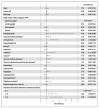Skilled Nursing Facility Use and Hospitalizations in Heart Failure: A Community Linkage Study
- PMID: 28365097
- PMCID: PMC5597448
- DOI: 10.1016/j.mayocp.2017.01.014
Skilled Nursing Facility Use and Hospitalizations in Heart Failure: A Community Linkage Study
Abstract
Objectives: To examine the effect of skilled nursing facility (SNF) use on hospitalizations in patients with heart failure (HF) and to examine predictors of hospitalization in patients with HF admitted to a SNF.
Patients and methods: Olmsted County, Minnesota, residents with first-ever HF from January 1, 2000, through December 31, 2010, were identified, and clinical data were linked to SNF utilization data from the Centers for Medicare and Medicaid Services. Andersen-Gill models were used to determine the association between SNF use and hospitalizations and to determine predictors of hospitalization.
Results: Of 1498 patients with incident HF (mean ± SD age, 75±14 years; 45% male), 605 (40.4%) were admitted to a SNF after HF diagnosis (median follow-up, 3.6 years; range, 0-13.0 years). Of those with a SNF admission, 225 (37%) had 2 or more admissions. After adjustment for age, sex, ejection fraction, and comorbidities, SNF use was associated with a 50% increased risk of hospitalization compared with no SNF use (adjusted hazard ratio, 1.52; 95% CI, 1.31-1.76). In SNF users, arrhythmia, asthma, chronic kidney disease, and the number of activities of daily living requiring assistance were independently associated with an increased risk of hospitalization.
Conclusion: Approximately 40% of patients with HF were admitted to a SNF at some point after diagnosis. Compared with SNF nonusers, SNF users were more likely to be hospitalized. Characteristics associated with hospitalization in SNF users were mostly noncardiovascular, including reduced ability to perform activities of daily living. These findings underscore the effect of physical functioning on hospitalizations in patients with HF in SNFs and the importance of strategies to improve physical functioning.
Copyright © 2017 Mayo Foundation for Medical Education and Research. Published by Elsevier Inc. All rights reserved.
Figures



Similar articles
-
Home Health Care After Skilled Nursing Facility Discharge Following Heart Failure Hospitalization.J Am Geriatr Soc. 2020 Jan;68(1):96-102. doi: 10.1111/jgs.16179. Epub 2019 Oct 11. J Am Geriatr Soc. 2020. PMID: 31603248 Free PMC article.
-
Risk of Readmission After Discharge From Skilled Nursing Facilities Following Heart Failure Hospitalization: A Retrospective Cohort Study.J Am Med Dir Assoc. 2019 Apr;20(4):432-437. doi: 10.1016/j.jamda.2019.01.135. J Am Med Dir Assoc. 2019. PMID: 30954133 Free PMC article.
-
Self-rated health predicts healthcare utilization in heart failure.J Am Heart Assoc. 2014 May 28;3(3):e000931. doi: 10.1161/JAHA.114.000931. J Am Heart Assoc. 2014. PMID: 24870937 Free PMC article.
-
Burden and Timing of Hospitalizations in Heart Failure: A Community Study.Mayo Clin Proc. 2017 Feb;92(2):184-192. doi: 10.1016/j.mayocp.2016.11.009. Mayo Clin Proc. 2017. PMID: 28160871 Free PMC article.
-
Discharge to a skilled nursing facility and subsequent clinical outcomes among older patients hospitalized for heart failure.Circ Heart Fail. 2011 May;4(3):293-300. doi: 10.1161/CIRCHEARTFAILURE.110.959171. Epub 2011 Mar 29. Circ Heart Fail. 2011. PMID: 21447803 Free PMC article.
Cited by
-
A Virtual Cardiovascular Care Program for Prevention of Heart Failure Readmissions in a Skilled Nursing Facility Population: Retrospective Analysis.JMIR Cardio. 2021 Jun 1;5(1):e29101. doi: 10.2196/29101. JMIR Cardio. 2021. PMID: 34061037 Free PMC article.
-
Risk of 30-Day Hospital Readmission Among Patients Discharged to Skilled Nursing Facilities: Development and Validation of a Risk-Prediction Model.J Am Med Dir Assoc. 2019 Apr;20(4):444-450.e2. doi: 10.1016/j.jamda.2019.01.137. Epub 2019 Mar 7. J Am Med Dir Assoc. 2019. PMID: 30852170 Free PMC article.
-
Health Literacy and Outcomes in Patients With Heart Failure: A Prospective Community Study.Mayo Clin Proc. 2018 Jan;93(1):9-15. doi: 10.1016/j.mayocp.2017.09.018. Epub 2017 Dec 6. Mayo Clin Proc. 2018. PMID: 29217337 Free PMC article.
-
Implementation of a Multimodal Heart Failure Management Protocol in a Skilled Nursing Facility.Gerontol Geriatr Med. 2023 Feb 3;9:23337214221149274. doi: 10.1177/23337214221149274. eCollection 2023 Jan-Dec. Gerontol Geriatr Med. 2023. PMID: 36755744 Free PMC article.
-
Vertical Integration Into Skilled Nursing Facilities and Hospital Readmission Rates.J Healthc Qual. 2020 Mar/Apr;42(2):91-97. doi: 10.1097/JHQ.0000000000000237. J Healthc Qual. 2020. PMID: 31977364 Free PMC article.
References
-
- Hunt SA, Abraham WT, Chin MH, et al. ACC/AHA 2005 Guideline Update for the Diagnosis and Management of Chronic Heart Failure in the Adult: a report of the American College of Cardiology/American Heart Association Task Force on Practice Guidelines (Writing Committee to Update the 2001 Guidelines for the Evaluation and Management of Heart Failure): developed in collaboration with the American College of Chest Physicians and the International Society for Heart and Lung Transplantation: endorsed by the Heart Rhythm Society. Circulation. 2005;112(12):e154–235. - PubMed
-
- Hunt SA, Abraham WT, Chin MH, et al. 2009 focused update incorporated into the ACC/AHA 2005 Guidelines for the Diagnosis and Management of Heart Failure in Adults: a report of the American College of Cardiology Foundation/American Heart Association Task Force on Practice Guidelines: developed in collaboration with the International Society for Heart and Lung Transplantation. Circulation. 2009;119(14):e391–479. - PubMed
-
- Jurgens CY, Goodlin S, Dolansky M, et al. Heart failure management in skilled nursing facilities: a scientific statement from the American Heart Association and the Heart Failure Society of America. Circ Heart Fail. 2015;8(3):655–687. - PubMed
Grants and funding
LinkOut - more resources
Full Text Sources
Other Literature Sources
Research Materials
Miscellaneous

